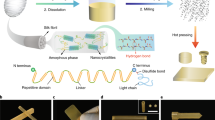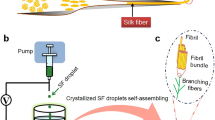Abstract
The present study described a new method with one step to fabricate silk fibroin nano- and microspheres, with the size of spheres and crystalline structure being controllable during processing. Polyethylene glycol, a type of synthetic polymer that is widely used in the pharmaceutical industry as a formulation excipient, was utilized to induce silk fibroin to self-assemble into nano- and microspheres. The addition of a certain amount of salt in the blending solution with subsequent titration into ethanol could improve the size dispersion, yield, and crystalline β-sheet structure (silk II) compared to those prepared without salt addition during preparation. Silk microspheres prepared in the presence of salts were less porous and more homogeneous in size than those prepared in the absence of salts.
This is a preview of subscription content, access via your institution
Access options
Subscribe to this journal
Receive 12 print issues and online access
$259.00 per year
only $21.58 per issue
Buy this article
- Purchase on Springer Link
- Instant access to full article PDF
Prices may be subject to local taxes which are calculated during checkout



Similar content being viewed by others
References
Rockwood DN, Preda RC, Yücel T, Wang X, Lovett ML, Kaplan DL. Materials fabrication from Bombyx mori silk fibroin. Nat Protoc. 2011;22:1612–31.
Yucel T, Lovett ML, Kaplan DL. Silk-based biomaterials for sustained drug delivery. J Control Release. 2014;190:381–97.
Youk H, Lee E, Choi M, Lee YJ, Chung JH, Kim SH, et al. Enhanced anticancer efficacy of α-tocopheryl succinate by conjugation with polyethylene glycol. J Control Release. 2005;107:43–52.
Sill K, Sullivan B, Carie A, Semple JE. Synthesis and characterization of micelle-forming PEG-poly(amino acid) copolymers with iron-hydroxamate cross-linkable blocks for encapsulation and release of hydrophobic drugs. Biomacromolecules. 2017;18:1874–84.
Wu J, Zheng Z, Li G, Kaplan DL, Wang X. Control of silk microsphere formation using polyethylene glycol (PEG). Acta Biomater. 2016;39:156–68.
Wang X, Yucel T, Lu Q, Hu X, Kaplan DL. Silk nanospheres and microspheres from silk/pva blend films for drug delivery. Biomaterials. 2010;31:1025–35.
Cao Z, Chen X, Yao J, Huang L, Shao Z. The preparation of regenerated silk fibroin microspheres. Soft Matter. 2017;3:910–5.
Lammel A, Hu X, Park S, Kaplan DL, Scheibel T. Controlling silk fibroin particle features for drug delivery. Biomaterials. 2010;31:4583–91.
Oktaviani NA, Matsugami A, Hayashi F, Numata K. Ion effects on the conformation and dynamics of repetitive domains of a spider silk protein: implications for solubility and b-sheet formation. Chem Commun. 2019;55:9761–4.
Wenk E, Wandrey AJ, Merkle HP, Meinel L. Silk fibroin spheres as a platform for controlled drug delivery. J Control Release. 2008;132:26–34.
Lammel A, Schwab M, Hofer M. Recombinant spider silk particles as drug delivery vehicles. Biomaterials. 2011;32:2233–40.
Zhou L, Chen X, Shao Z, Huang Y, Knight DP. Effect of metallic ions on silk formation in the Mulberry silkworm, Bombyx mori. J Phys Chem B. 2005;109:16937–45.
Nogueira GM, Rodas ACD, Leite CAP, Giles C, Higa HZ, Polakiewicz B, et al. Preparation and characterization of ethanol-treated silk fibroin dense membranes for biomaterials application using waste silk fibers as raw material. Bioresour Technol. 2010;101:8446–51.
Warwicker JO. The crystal structure of silk fibroin. Acta Crystallogr. 1956;7:565–73.
Luo T, Yang L, Wu J, Zheng Z, Li G, Wang X, et al. Stabilization of natural antioxidants by silk biomaterials. ACS Appl Mater Inter. 2016;8:13573–82.
Gong H, Wang J, Zhang J, Wu J, Zheng Z, Xie X, et al. Control of octreotide release form silk fibroin microsphere. Mat Sci Eng C-Mater. 2019;102:820–8.
Acknowledgements
The study was financially supported by the Natural Science Foundation of China grant (Project no. 51903019), the Nature Science Foundation of Jiangsu Province (Grant no. BK 20181038), and the Natural Science Foundation of Colleges in Jiangsu Province (Project no. 19KJB430006).
Author information
Authors and Affiliations
Corresponding author
Ethics declarations
Conflict of interest
The authors declare that they have no conflict of interest.
Additional information
Publisher’s note Springer Nature remains neutral with regard to jurisdictional claims in published maps and institutional affiliations.
Rights and permissions
About this article
Cite this article
Wu, J., Guo, W., Zhang, L. et al. One-step preparation and characterization of silk nano- and microspheres. Polym J 52, 1395–1400 (2020). https://doi.org/10.1038/s41428-020-0392-z
Received:
Revised:
Accepted:
Published:
Issue Date:
DOI: https://doi.org/10.1038/s41428-020-0392-z



